|
Old-fashioned
Grain Soups
… for hearty,
healthy eating all winter long
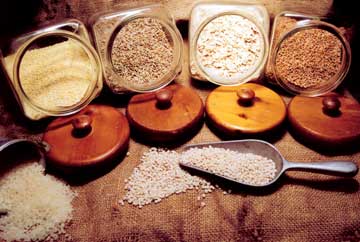 by
Linda Gabris by
Linda Gabris
During these blustery, cold days of winter,
nothing warms the body and soul like a steaming bowl of fragrant
grain soup.
Some of my most cherished soup recipes
are those that were handed down to me by my grandmother who
excelled at making delicious, hearty soups out of an array
of common, inexpensive grains.
“If you’ve got a handful of
grain,” Grandma’d wink as she heated up her big
cast iron soup pot on top of the crackling woodstove, “you’ve
got fixin’s for great soup.”
My grandparents relied upon being self-sufficient.
It was important to have the pantry and root cellar well-stocked
before cold weather struck. After putting up bounty from their
huge garden and stowing away Mother’s Nature’s offerings
from backyard woodlands, there was never any fear of going
hungry, even if snowbound for months. Sacks of grains topped
their list of staples that were ordered from town each fall.
Unlike Grandmother, I have year-round
access to grocery stores, but I still take great comfort in
stocking my cupboard with an assortment of grains for making
old-fashioned winter soups whenever the urge arises.
I don’t buy grain by the bushel as
Grandma did, but I do have enough on hand at any given time.
Over the years I’ve even added a few new grains to my
soup pot like millet and brown rice, which Grandmother never
had the luxury of using. The more common picks were wheat,
oats, corn, barley, rye and plain white rice. When you’re
buying grain, always try to choose organically grown and once
home with your purchase, store it in a tightly covered container
on a cool pantry shelf.
It’s fascinating that grains contain
all the basic nutrients needed for good health. They provide
significant amounts of protein, complex carbohydrates, vitamins,
minerals, fibre and are low in fat, containing no cholesterol.
Grandma used to quip after giving thanks for our daily bread,
that it was not so much the bread we were praising—but
rather the precious grains from which it was baked.
All the grains are interchangeable, so
no two soups ever have to be the same—in my house, no
two ever are! You can even mix and match grains for exciting
variety. Don’t forget that grains can serve as a healthy,
filling substitute for noodles in almost any soup.
Keep in mind that grains absorb liquids
and swell greatly upon cooking. Most types, especially millet
and barley, can increase up to four times their original size,
so do not add more than the recipe calls for unless you purposely
want a thicker soup—too much and you’ll end up with
porridge! If soup has become too thick upon sitting, you can
add a bit of water or stock to thin it down, if desired.
|
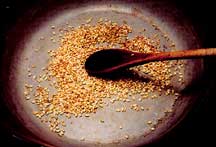 The
secret to great grain soup The
secret to great grain soup
Dry roast the grain before adding
it to the pot. This produces a nutty aroma and rich
broth. Heat a heavy-bottomed skillet until a drop of
water sizzles. Like Grandma, I find that nothing beats
cast iron for roasting grain as it holds and distributes
heat evenly.
Rinse grain in cold water. Let drip-dry
in sieve, then pat dry on paper towels. This removes
any grit and some of the excess starch, especially in
rice.
Empty cleaned grain into pan and
stir constantly with wooden spoon until roasted as directed
in each recipe. Do not over-roast as this can cause
a burnt taste.
When grain is ready, empty into
soup pot and proceed. Go ahead and let your creative
juices flow.
|
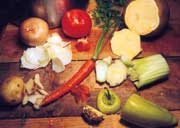 HOMEMADE
VEGETABLE STOCK FROM SCRAPS HOMEMADE
VEGETABLE STOCK FROM SCRAPS
Some soup recipes call for vegetable stock.
You can use vegetable bouillon or cubes, but making your own
stock from scratch is so much better, easy and economical.
I keep a special container in my fridge that catches all my
veggie discards like fleshy onion and potato peelings, outer
cabbage leaves and heart, carrot and parsnip scrapings, turnip
trims, celery leaves, stripped parsley stems, pepper pulp
and seeds, and other bits that’ll yield flavour in my
stock pot. Just remember to scour veggies while still whole.
To make stock, empty scraps into pot and
add about a quart of water. Bring to boil, reduce heat and
simmer covered until every last vitamin, mineral and drop
of flavour has been extracted. Season with salt, pepper and
any spice or herb that tickles your fancy. Strain and discard
scraps. Simple soups can be made by adding roasted grains
to stock and simmering until tender.
TIP: The more carrot scraps you use, the richer the stock will
be both in flavour and colour.
Each recipe makes about 8 to 10 cups
of soup. Recipes can be halved or even doubled if needed.
Leftover soup can be frozen for another day’s fare. I
make big batches so I can always have a handy thermosfull
to take the chill out of snowy trails. I freeze leftover soup
in zip lock bags in amounts to suit my thermos—making
it easy to thaw, heat and tote.
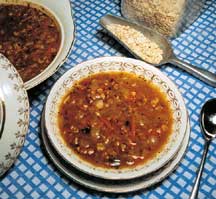 OATMEAL
AND ONION SOUP OATMEAL
AND ONION SOUP
Here’s a fragrant, filling soup that’s
supper in itself.
3 tablespoons large oat flakes
1 tablespoon vegetable oil
4 large, finely chopped onions
2 cloves minced garlic
3 grated carrots
6 cups vegetable stock
pinch of dried basil
Toast oat flakes, stirring constantly
until they are golden. Empty from pan and set aside. Put oil
in skillet. Add onions and garlic, sauté until onions
are soft. Empty into soup pot and add remaining ingredients,
except oats. Bring to a boil, reduce heat and simmer, covered,
15 minutes. Sprinkle oats into soup and simmer, uncovered,
another 5 minutes. Taste and adjust seasoning.
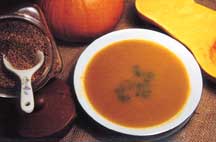 WHEAT
BERRY AND SQUASH SOUP WHEAT
BERRY AND SQUASH SOUP
Grandpa grew an array of squash in his
backyard garden—enough to fill the root cellar to last
all winter long! You can use butternut, pumpkin or any squash
you favour. This is an interesting soup—tender wheat
berries swimming in smooth puréed squash. (Also great
when made with rye kernels, barley, rice or millet)
1/2 cup wheat berries (or 1/2 cup rye
kernels, 1/4 cup barley or rice, or 2 tablespoons millet)
1 butternut or other medium-sized squash, peeled and cubed
water
4 cups vegetable stock
Toast wheat (or rye) kernels until they
start to pop. (Toast barley, rice or millet until golden).
Set aside. Put squash into pot with just enough lightly salted
water to cover, bring to boil, reduce heat and simmer until
soft. Puree until smooth. Add vegetable stock and wheat kernels.
Simmer until kernels are tender. Taste and adjust seasoning.
Garnish with parsley.
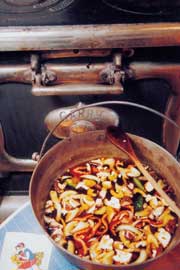 LIZZY’S
ORIENTAL RICE SOUP LIZZY’S
ORIENTAL RICE SOUP
Grandma had hundreds of ancient, rice
soup recipes in her collection. Here’s a new-fangled
version using shiitake mushrooms. Because the stalks on these
mushrooms are fibrous, they should be removed. They can be
saved for adding flavour to stocks, then dicarded upon straining.
By the way, this soup is named after me…
1/2 cup rice
6 cups water
6 dried shiitake mushrooms, without stalks, broken into
pieces
3/4 cup sliced celery
2 sliced carrots
1/2 cup each of cauliflower and broccoli flowerets
1/2 cup red, yellow and/or green peppers, coarsely chopped
3 tablespoons of soy sauce or enough to turn soup rich brown
few drops of sesame oil
1 small hot pepper or drop of chilli oil (optional)
Toast rice until evenly golden. Set aside.
Put water into soup pot and add shiitakes. Bring to boil,
reduce heat, cover and simmer until mushrooms bits are plump.
Add rice and simmer covered for 10 minutes. Add remaining
ingredients (and any other veggies you desire), cover and
simmer until vegetables are tender, but not soft. Taste and
adjust seasoning. Garnish with finely sliced green onion.
OLD WORLD CORN CHOWDER
 In
the fall, after corn was harvested, Grandma’d peel dozens
of ears, tie them together by the husks and hang them to dry
in the attic. This is the corn she’d use to make her
delicious corn chowder. I’ve updated the recipe using
store-bought or home-canned corn which produces great chowder—almost
as good as Gram’s! When making chowder from fresh corn,
it can be cut from the cob, roasted in 475°F oven under
broiler until golden. This produces a rich, golden chowder. In
the fall, after corn was harvested, Grandma’d peel dozens
of ears, tie them together by the husks and hang them to dry
in the attic. This is the corn she’d use to make her
delicious corn chowder. I’ve updated the recipe using
store-bought or home-canned corn which produces great chowder—almost
as good as Gram’s! When making chowder from fresh corn,
it can be cut from the cob, roasted in 475°F oven under
broiler until golden. This produces a rich, golden chowder.
1 quart canned corn or about 4 cups
3 cups vegetable stock
4 tablespoons fine cornmeal blended into 1 cup soy milk (more
or less depending on how thick you like your chowder)
Empty corn and juice into soup pot and
add stock. Bring to boil, reduce heat and simmer covered for
5 minutes. Add soy milk mixture and heat, stirring constantly
until thick and smooth. Season with salt and pepper. Garnish
with a pinch of basil or a snip of chives. Serve with corn
cakes on the side for dunking.
GOLDEN CORN CAKES
1 1/2 cups flour
1 1/2 cups yellow cornmeal
3 teaspoons baking power
3 tablespoons sugar
2 tablespoons vegetable oil
water
Combine all ingredients, using enough
water to bind. Heat heavy skillet and lightly oil. Drop batter
by spoonful and fry cakes until golden on both sides. (Makes
6 to 8 corn cakes.)
This is an original story,
first published in The Country Connection Magazine,
Issue 48, Winter 2005. Copyright Linda Gabris.
RETURN
TO STORY INDEX
RETURN
TO BACK ISSUE PAGE
RETURN
TO RECIPE PAGE
|

